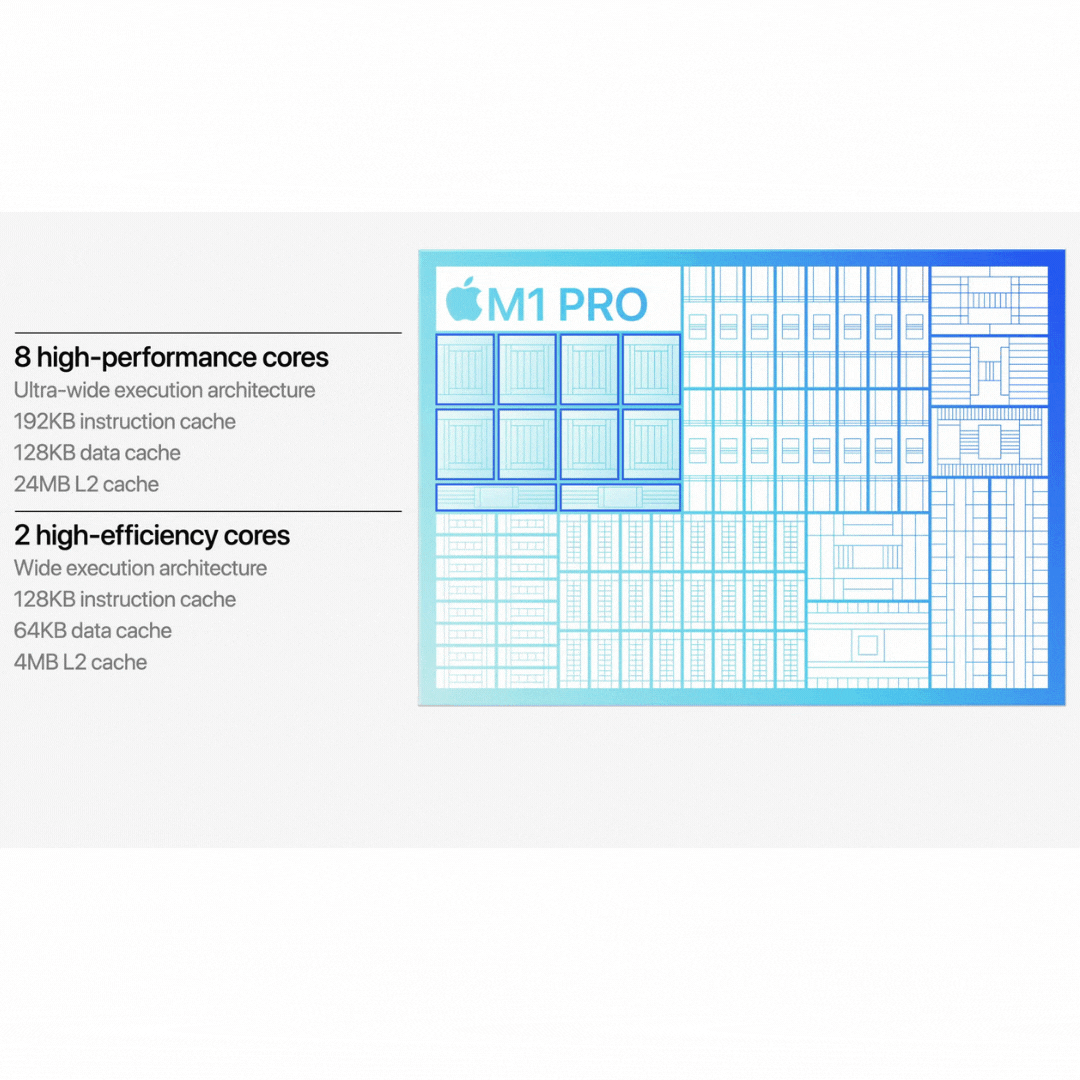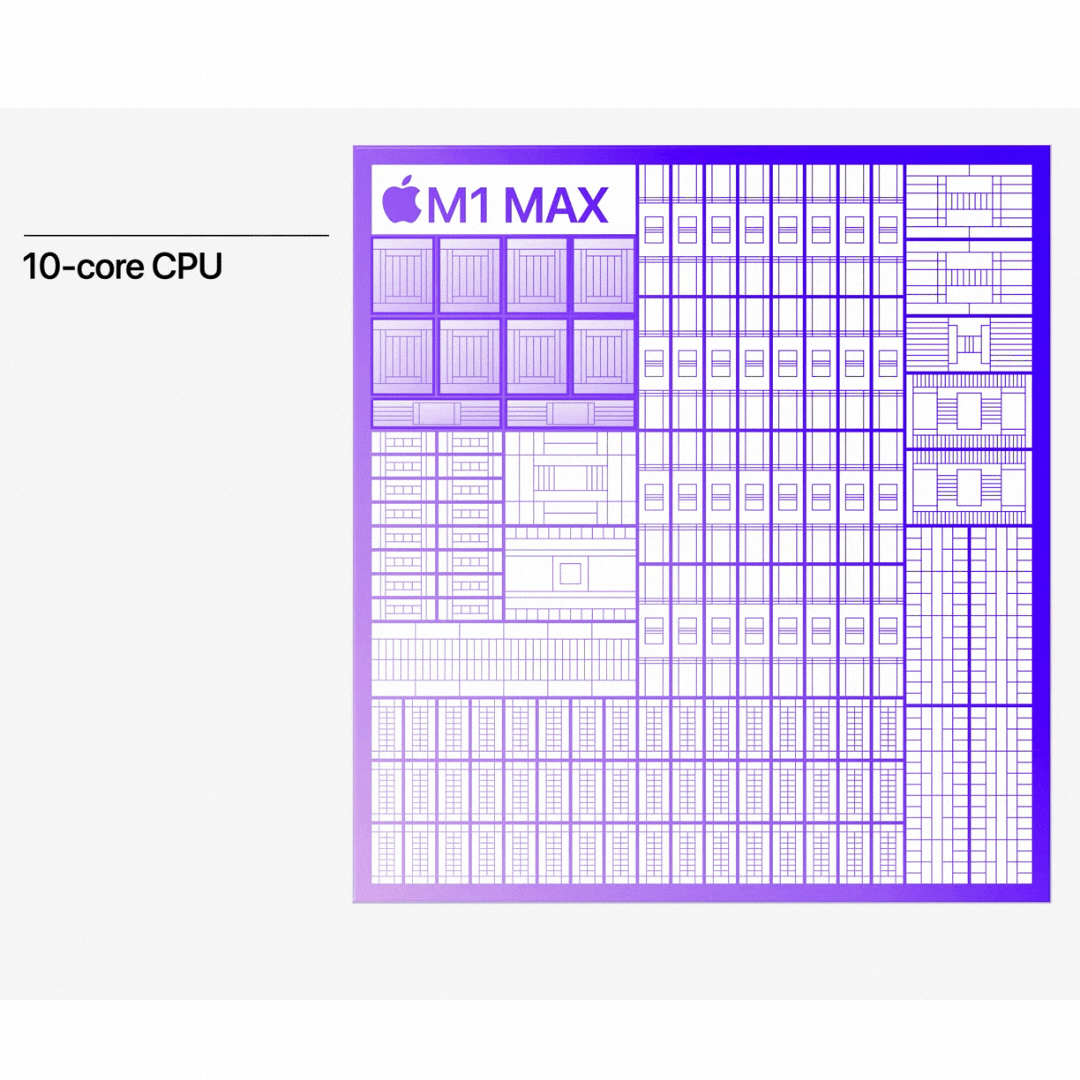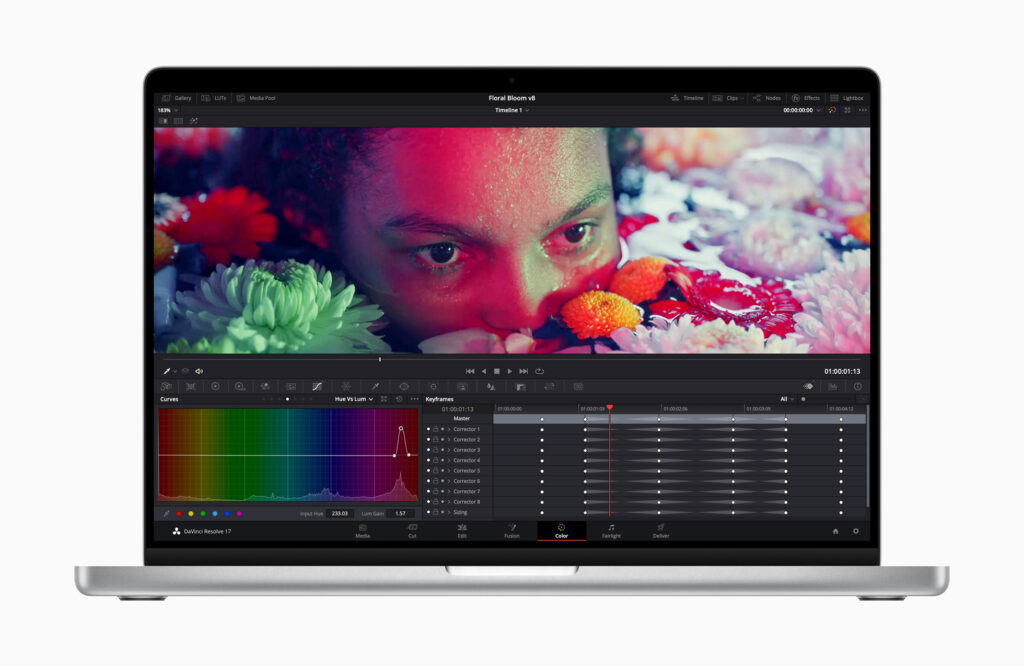Apple introduces M1 Max world’s most powerful Notebook chip. M1 Pro and M1 Max new CPUs with up to a 10-core CPU, 32-core GPU, 64GB of unified memory, ProRes acceleration, and industry-leading power efficiency power the all-new MacBook Pro.
CUPERTINO, CALIFORNIA October 18, 2021 – M1 Pro and M1 Max, Apple’s next breakthrough CPUs for the Mac, were revealed today. M1 Pro combines exceptional performance with industry-leading power efficiency, while M1 Max pushes these capabilities to new heights by scaling up M1’s transformative architecture. The CPU in the M1 Pro and M1 Max is up to 70% quicker than the M1, making processes like building apps in Xcode faster than ever before. M1 Pro’s GPU is up to 2x faster than M1’s, and M1 Max’s GPU is up to 4x faster than M1, allowing professionals to breeze through even the most demanding graphics workloads.

For the first time in pro systems, the M1 Pro and M1 Max include a system-on-a-chip (SoC) architecture. Fast unified memory, industry-leading performance per watt, and amazing power efficiency, as well as enhanced memory bandwidth and capacity, are all features of the processors. The M1 Pro supports up to 32GB of unified memory and has a memory bandwidth of up to 200GB/s. M1 Max has a memory bandwidth of up to 400GB/s, which is 2x that of M1 Pro and roughly 6x that of M1, as well as compatibility for up to 64GB of unified memory.
While the latest PC laptops have a maximum graphics memory of 16GB, having this much memory allows for graphics-intensive workflows that were previously unthinkable on a notebook. Because of the M1 Pro and M1 Max’s efficient architecture, they give the same level of performance whether the MacBook Pro is plugged in or running on battery power. The M1 Pro and M1 Max also have improved media engines with dedicated ProRes accelerators for professional video processing. The M1 Pro and M1 Max are Apple’s most powerful processors to date.
[email-subscribers-form id=”1″]

“M1 has transformed our most popular systems with incredible performance, custom technologies, and industry-leading power efficiency. No one has ever applied a system-on-a-chip design to a pro system until today with M1 Pro and M1 Max,” said Johny Srouji, Apple’s senior vice president of Hardware Technologies. “With massive gains in CPU and GPU performance, up to six times the memory bandwidth, a new media engine with ProRes accelerators, and other advanced technologies, M1 Pro and M1 Max take Apple silicon even further, and are unlike anything else in a pro notebook.”

M1 Pro: A Whole New Level of Performance and Capability
M1 Pro has 33.7 billion transistors, more than twice as many as M1, thanks to the industry-leading 5-nanometer manufacturing technology. A new 10-core CPU with eight high-performance cores and two high-efficiency cores outperforms the M1 by up to 70%, resulting in incredible pro CPU performance. When compared to the latest 8-core PC laptop processor, the M1 Pro delivers up to 1.7x greater CPU performance at the same power level and uses up to 70% less power to achieve the PC chip’s peak performance. 1 M1 Pro is capable of handling even the most demanding jobs, such as high-resolution photo editing.
M1 Pro contains a 16-core GPU, which is up to 2x faster than M1 and up to 7x quicker than the integrated graphics on the most recent 8-core PC laptop chip. 1 When compared to a strong discrete GPU for PC notebooks, the M1 Pro delivers up to 70% better performance while utilizing 70% less power. 2 M1 Pro can also be customized with up to 32GB of fast unified memory and up to 200GB/s of memory bandwidth, allowing 3D artists and game developers to do more on the road than ever before.


M1 Max: M1 Max world’s most powerful Notebook chip
M1 Max world’s most powerful Notebook chip has the same strong 10-core CPU as M1 Pro, but it also has a large 32-core GPU that delivers up to 4x faster graphics performance than M1. M1 Max is Apple’s largest chip, with 57 billion transistors, 70 percent more than M1 Pro and 3.5 times more than M1. Furthermore, the GPU provides performance comparable to a high-end GPU in a compact pro PC laptop while consuming up to 40% less power, as well as performance comparable to the highest-end GPU in the largest PC laptops while consuming up to 100 watts less power.
This means less heat is generated, fans run silently and less frequently, and the new MacBook Pro’s battery life is excellent. When compared to the previous-generation 13-inch MacBook Pro, the M1 Max changes graphics-intensive operations, including up to 13x faster-complicated timeline rendering in Final Cut Pro.

M1 Max also has a higher-bandwidth on-chip fabric and twice the memory interface over M1 Pro, allowing for up to 400GB/s of memory bandwidth, or approximately 6x that of M1. As a result, the M1 Max may be equipped with up to 64GB of rapid unified memory. M1 Max is the most powerful chip ever built for a professional notebook, with unrivaled performance.

Graphics Performance: Fast, Efficient Media Engine, Now with ProRes:
The Apple-designed media engine in the M1 Pro and M1 Max speeds up video processing while extending battery life. M1 Pro also incorporates specialized ProRes video codec acceleration, enabling the simultaneous playing of several streams of high-quality 4K and 8K ProRes video while consuming very little power. M1 Max goes even farther, with two ProRes accelerators and up to 2x quicker video encoding than M1 Pro. When compared to the previous-generation 16-inch MacBook Pro, the new MacBook Pro with M1 Max can transcode ProRes video in Compressor up to 10x faster.


Neural Engine Thunderbolt 4 & Apple’s custom image signal processor:
M1 Pro and M1 Max both come with a slew of powerful proprietary innovations that help professionals take their workflows to the next level:
- A 16-core Neural Engine for enhanced camera performance and on-device machine learning acceleration.
- Multiple external displays are driven by a novel display engine.
- Additional Thunderbolt 4 controllers are integrated to provide even more I/O bandwidth.
- Apple’s own image signal processor, in conjunction with the Neural Engine, employs computational video to improve image quality on the built-in camera, resulting in clearer video and more natural-looking skin tones.
- Apple’s newest Secure Enclave, hardware-verified secure boot, and runtime anti-exploitation technologies provide best-in-class security.
The Mac has now been on Apple silicon for a year, and the M1 Pro and M1 Max are still another significant step forward. These are Apple’s most powerful and capable chips to date, and they join the M1 to form a chip family that leads the industry in performance, custom technology, and power efficiency.

macOS, Apps with M1 Pro and M1 Max
macOS Monterey is designed to unleash the full potential of the M1 Pro and M1 Max, giving an exceptional performance, pro features, and battery life. The Mac comes up instantaneously from sleep, and the entire system is speedy and very responsive, thanks to Monterey’s design for Apple silicon. Apps can take full advantage of the new CPUs thanks to developer tools like Metal, while Core ML optimizations use the powerful Neural Engine to make machine learning models run even faster.
Advanced power management capabilities intelligently allocate workloads between the performance and efficiency cores for both exceptional speed and battery life, and pro app workload data is utilized to assist optimize how macOS assigns multi-threaded activities to the CPU cores for best performance.

macOS with M1, M1 Pro, or M1 Max also provides industry-leading security features like a hardware-verified safe boot, runtime anti-exploitation technologies, and rapid, in-line file encryption. There are nearly 10,000 Universal programs and plug-ins available, and all of Apple’s Mac apps are optimized for — and run natively on — Apple silicon. Existing Mac apps that have not been updated to Universal will work with Apple’s Rosetta 2 technology, and users will be able to run iPhone and iPad apps directly on the Mac, opening up a whole new world of possibilities.
Apple is currently carbon neutral in its global operations, and by 2030, the company expects to have a net-zero climate impact throughout the whole organization, including manufacturing supply chains and all product life cycles. This also means that every chip Apple makes will be carbon-neutral from design to production.

